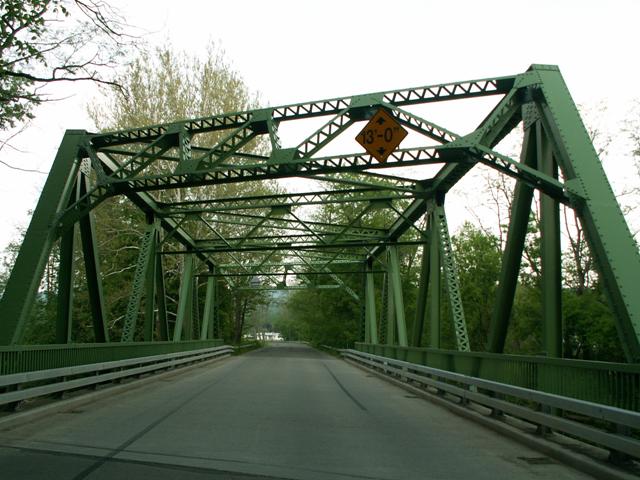We Recommend:
Bach Steel - Experts at historic truss bridge restoration.
BridgeHunter.com Phase 1 is released to the public! - Visit Now
Apalachin Bridge

Primary Photographer(s): Nathan Holth
Bridge Documented: May 26, 2007
Apalachin: Tioga County, New York: United States
2002
130.0 Feet (39.6 Meters)
132.0 Feet (40.2 Meters)
27.2 Feet (8.29 Meters)
1 Main Span(s)
2218760

View Information About HSR Ratings
Bridge Documentation
View Archived National Bridge Inventory Report - Has Additional Details and Evaluation
The state of New York, like neighboring Pennsylvania, continued to rely on the metal truss bridge into the first third of the 20th Century, developing a standard plan for metal truss bridges and building them with moderate frequency. Unlike Pennsylvania, which went with the Pratt and Parker truss configurations, New York engineers instead went with the Warren and Warren Polygonal truss configurations. A number of these structures survive today in New York. They all feature riveted connections and "massive" members and have what would have been at the time a relatively wide deck width. Today in the 21st century, the continuity from the standard plan design is psychologically enhanced by the fact that nearly all of these bridges in New York are painted in the same green color. Despite the fact that they are late examples of truss bridge construction, and a relatively fair number remain, they still represent a structure type no longer built today, and are also highly attractive structures that make crossing a bridge something to notice and enjoy. They are also, if properly maintained, strong bridges that are more than capable of serving modern traffic needs safely and efficiently. For all these reasons, the maintenance and preservation of these structures makes sense for fiscal reasons, but also for the greater purpose of preserving these attractive structures, which offer a window into past forms of fabrication, construction, and engineering.
The Apalachin Bridge is an excellent example of one of these bridges. It has been well maintained and recently rehabilitated. It is also notably skewed, adding to its significance. New York has made the right step in choosing to rehabilitate this structure. Now it is important that they remain committed to routine maintenance of the structure, to ensure that this structure can remain for decades to come.
![]()
Photo Galleries and Videos: Apalachin Bridge
Bridge Photo-Documentation
A collection of overview and detail photos. This photo gallery contains a combination of Original Size photos and Mobile Optimized photos in a touch-friendly popup viewer.Alternatively, Browse Without Using Viewer
![]()
Maps and Links: Apalachin Bridge
Coordinates (Latitude, Longitude):
Search For Additional Bridge Listings:
Bridgehunter.com: View listed bridges within 0.5 miles (0.8 kilometers) of this bridge.
Bridgehunter.com: View listed bridges within 10 miles (16 kilometers) of this bridge.
Additional Maps:
Google Streetview (If Available)
GeoHack (Additional Links and Coordinates)
Apple Maps (Via DuckDuckGo Search)
Apple Maps (Apple devices only)
Android: Open Location In Your Map or GPS App
Flickr Gallery (Find Nearby Photos)
Wikimedia Commons (Find Nearby Photos)
Directions Via Sygic For Android
Directions Via Sygic For iOS and Android Dolphin Browser
USGS National Map (United States Only)
Historical USGS Topo Maps (United States Only)
Historic Aerials (United States Only)
CalTopo Maps (United States Only)

